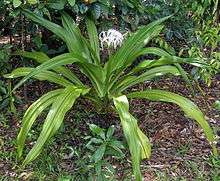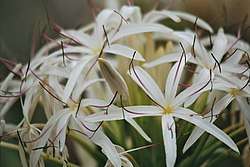Crinum pedunculatum
Crinum pedunculatum[1] also known as the swamp lily, river lily or mangrove lily, is a bulbous perennial found in stream and tidal areas of the Northern Territory, Queensland and New South Wales, Australia as well as New Guinea and some Pacific Islands. It is unclear whether it is native or introduced to Norfolk Island.[2]
| Crinum pedunculatum | |
|---|---|
 | |
| Crinum pedunculatum in Cooktown, Australia | |
| Scientific classification | |
| Kingdom: | Plantae |
| Clade: | Tracheophytes |
| Clade: | Angiosperms |
| Clade: | Monocots |
| Order: | Asparagales |
| Family: | Amaryllidaceae |
| Subfamily: | Amaryllidoideae |
| Genus: | Crinum |
| Species: | C. pedunculatum |
| Binomial name | |
| Crinum pedunculatum | |
| Synonyms | |
|
Crinum asiaticum var. pedunculatum (R.Br.) Fosberg & Sachet | |
C. pedunculatum is considered by some sources to be a synonym of Crinum asiaticum var. pedunculatum.[3] The differences between C. asiaticum and C. pedunculatum are subtle. The latter tends to be somewhat smaller, but has broader petals, giving it a less fragile appearance.
It is a very large bulbous perennial plant, up to 2 to 3 metres tall, with a spread of up to 3 metres. It likes either full sun or partial shade. It is usually found on the edge of forests, but also at the high tide level close to mangroves.
The white, fragrant flowers are in a cluster with 10 to 100 flowers on an umbel.
Cultivation and uses
C. pedunculatum makes a beautiful feature plant in a large garden. It prefers a fairly well shaded position. It is a good container plant if kept well-watered. The sap has been used as a treatment for box jellyfish stings.[4]
Propagation
The flowers produce a small bulb, or the larger bulbs in the ground may be transplanted.
References
- Beasley, John. 2006. Plants of Tropical North Queensland: the Compact Guide. Footloose Publications, Kuranda. ISBN 1-876617-13-6.
- Fay, Michael F. and Mark W. Chase. "Resurrection of Themidaceae for the Brodiaea alliance, and Recircumscription of Alliaceae, Amaryllidaceae and Agapanthoideae." Taxon, Vol. 45, No. 3. (Aug., 1996), pp. 441–451.
- Scarth-Johnson, Vera. 2000. National Treasures: Flowering Plants of Cooktown and Northern Australia. Vera Scarth-Johnson Gallery Association. ISBN 0-646-39726-5 (pbk.) ISBN 0-646-39725-7 Limited Edition - Leather Bound.
- "Crinum pedunculatum". Australian Plant Name Index (APNI), IBIS database. Centre for Plant Biodiversity Research, Australian Government.
- "Crinum asiaticum var. pedunculatum". Flora of Australia Online. Department of the Environment and Heritage, Australian Government.
- World Checklist of Selected Plant Families, The Board of Trustees of the Royal Botanic Gardens, Kew, retrieved 2011-05-25, search for "Crinum pedunculatum"
- Hyland, B. P. M.; Whiffin, T.; Zich, F. A.; et al. (Dec 2010). "Factsheet – Crinum pedunculatum". Australian Tropical Rainforest Plants (6.1, online version RFK 6.1 ed.). Cairns, Australia: Commonwealth Scientific and Industrial Research Organisation (CSIRO), through its Division of Plant Industry; the Centre for Australian National Biodiversity Research; the Australian Tropical Herbarium, James Cook University. Retrieved 28 January 2016.
External links
.jpg) Watercolour by George Raper (1789). It depicts the detail of flower and seeds above image of whole plant.
Watercolour by George Raper (1789). It depicts the detail of flower and seeds above image of whole plant..jpg) Crinum pedunculatum growing in cultivation at Birmingham Botanical Gardens, Birmingham, UK
Crinum pedunculatum growing in cultivation at Birmingham Botanical Gardens, Birmingham, UK Inflorescence of Crinum pedunculatum growing in cultivation at Birmingham Botanical Gardens, Birmingham, UK
Inflorescence of Crinum pedunculatum growing in cultivation at Birmingham Botanical Gardens, Birmingham, UK Swamp Lily on Fraser Island, Australia
Swamp Lily on Fraser Island, Australia Swamp Lily flower. Cooktown, Australia
Swamp Lily flower. Cooktown, Australia Swamp Lily flowers closeup. Cooktown, Australia
Swamp Lily flowers closeup. Cooktown, Australia